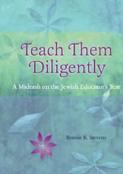- Home
- Play & Learn Home
- Online Enrichment
- Experience Modern Israel
- Israel It's Complicated
- Jewish and Me
- Jewish Holidays Jewish Values
- Jewish Values in Genesis and Jewish Values in Exodus
- Min Ha’aretz
- Our Place in the Universe
- Simply Seder
- The Prophets: Speaking Out for Justice
- Making T'filah Meaningful
- Make, Create, Celebrate
- Yom Haatzmaut Resources
- Hebrew Apps
- About The OLC
- What is the OLC?
- Introduction
- Get Started
- Resources
- OLC Content
- Parent Materials
- See My OLC Classes
- Store
Discover Inspiration and Advice for Teachers in the Themes of Tu B’Shevat
Written by Behrman House Staff, 16 of January, 2012
If you should happen to have a sapling in your hand when they tell you the Messiah is coming, first finish planting, then go out and greet the Messiah. --Yochanan ben Zakkai, Avot de-Rabbi Natan 31b
Yochanan ben Zakkai was, above all, a teacher. On the most famous night of his life, when Jerusalem was about to fall and Judaism itself faced extinction, he risked death by pretending to die. He had his students carry him outside the city in a coffin, he confronted the Roman general, and he delivered his startling prophecy, declaring that the general would soon be named emperor of Rome—his shrewd prophect grounded in fact. And, when the prophecy proved accurate and the general offered him a reward, ben Zaccai asked for permission to found a school. How fearful for Judaism’s future ben Zaccai must have felt that night; how natural it would have been for him to yearn for the miraculous arrival of the Messiah to save his city and his religion. Sadly, the Messiah did not come, and Jerusalem, for cruelly long centuries, was lost. But the sages who taught at ben Zaccai’s school kept Judaism alive.
Our religion, and our people, survived devastating loss and exile because Jewish education went on in its gradual but unyielding way, lesson after patient lesson, class after careful class.
In her book Teach Them Diligently: A Midrash on the Jewish Educator’s Year, Bonnie K. Stevens thus links ben Zaccai’s inspired metaphor of the importance of trees with his reputation as a teacher supremely committed to the future of Judaism through education. In applying the Tu B’Shevat themes of planting, nurturing, and blossoming to the interactions of teacher and student as they come together to learn, Stevens combines inspiration and hope in the educator’s work for the future with practical suggestions for lessons that engage students and keep Jewish learning lively.
Here are some of her suggestions, from the book:
Create opening rituals. These can help students make the transition from ordinary activities to study, and can make a class seem coherent and orderly. It will probably work best if it is something the students enjoy, and something repeated often enough to create a sense of order and expectation.
Vary activities. Combine a number of activities that allow for whole class, small group, and individual work to keep things moving. For example, introduce a topic to the full class with a brief presentation, have students break into pairs or small groups to discuss, create a skit, or find an answer to a question, then come back together to share or compare ideas. Show brief videos, play a game, or take them to a relevant website to add variety.
Count to ten. To start a discussion, ask a question and then count to ten—silently and slowly—to allow students time to respond. Give students time, and they will often surprise with the depth and originality of their comments. If you still don’t get a response, have students jot down their ideas, then ask them to share what they have written. Even students who are reluctant to talk in class are usually willing to write out their ideas and then share them when invited to do so.
Reflect in writing. Taking a few minutes for writing can also be an effective way to end a discussion. We can ask students to reflect for a moment and write a sentence or two summing up what they see as the most important idea discussed. This also helps us check up on how well students have understood a lesson.
Leave time to wind down. End class with a winding down activity and closing ritual. Keep a careful eye on the time to be able to stop at least five minutes before dismissal in order to end the session in an orderly, useful way.
Extend class time. Create opportunities to keep students learning and interested after class ends. If you have access to an online space or service, send or post quick messages in between classes such as a reminder about a special Temple event, a comment about something that’s happened in Israel, or simply wishing them a Shabbat Shalom. Establish a reward system that lets the class earn special treats for completing short homework assignments. Send eCards for upcoming holidays.
Remember that as Jewish educators, we may or may not see the affirmation of our efforts, but we can be sure that affirmation exists. By teaching, we repay our debts to our own teachers, and we keep planting the seeds that nourish the next generation of teachers and help them keep working—class after careful class, lesson after patient lesson, until the Messiah comes.*
Find inspiration for teaching throughout the Jewish year in Teach Them Diligently
Find ideas for structuring lessons, adding variety to class activities, and successfully winding down at the end of each class in Behrman House’s new line of Lesson Plan Manuals.These sets of ready-to-use lesson plans are available for core subjects including Holidays, Israel, Bible, Prophets, and Jewish Values in several grade levels, and are matched to specific Behrman House books.
Prepare lessons, find and show videos, provide an online class discussion space, extend class time using the Behrman House Online Learning Center.
(*Article excerpted and adapted from Teach Them Diligently, by Bonnie K. Stevens.)



